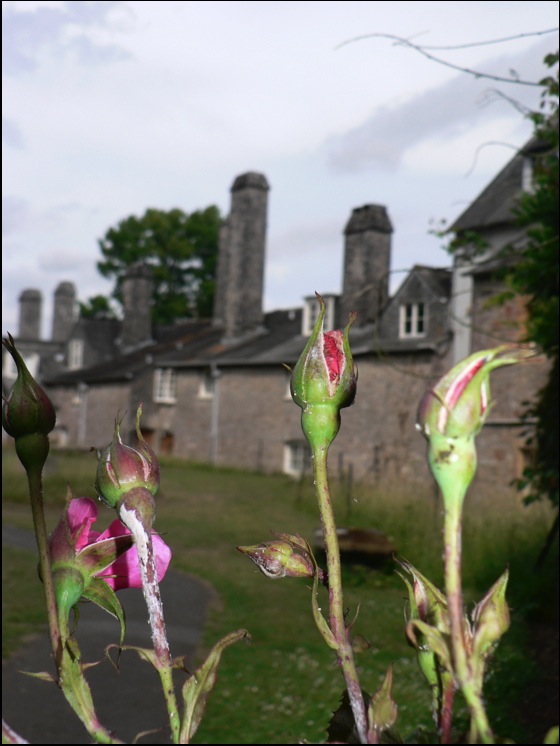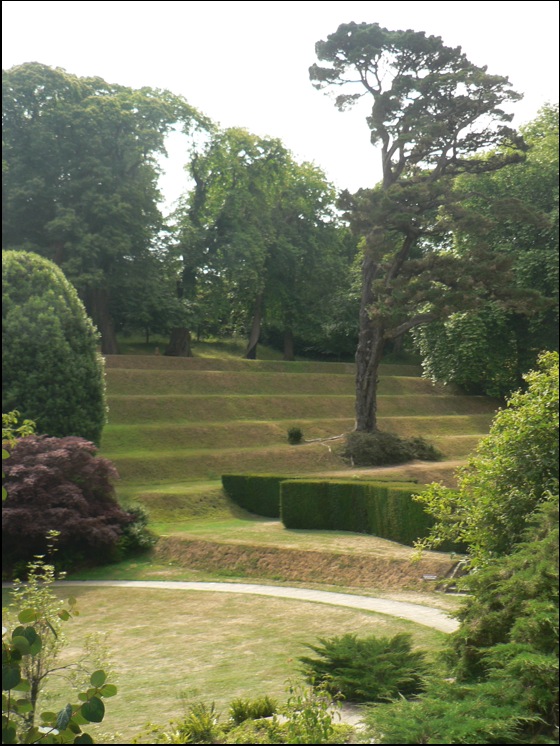Jul 2010
The geographical delights of Port Eliot
Wednesday, 28 July, 2010. Filed under: Lie of the Land
I’ve been away for a few days at Port Eliot for Part 1 of my official launch of the BLC - Part 2 is at Camp Bestival this weekend at 6.20 pm in the tent of the East Lulworth Literary Institute, along with some Jurassic thoughts.
Maybe I’ll see you there, but in the meantime, here are some shots of the Port Eliot landscape and some thoughts about it. The immediate area is a complex one with hard volcanic lavas, ash and ‘tuffs’ making up a west-east ridge of high ground to the estuaries of the Rivers Tiddy and Lynher, while two separate areas of rough slate - which the Cornish refer to as ‘killas’ - run to the north and south of the ridge. The Caught by the River tent was situated in a small quarry which may have provided some killas for the estate walls. You can see the high ground in the first picture and its continuation on the far side of the Tiddy in the second picture - the line of trees mark the course of a cutting that takes the Great Western line towards Plymouth. The lava and ash made their way into the landscape during a time that Southern Britain and Scotland were being welded together around 400 or so million years ago and a Himalayan range of mountains was being formed to the North.
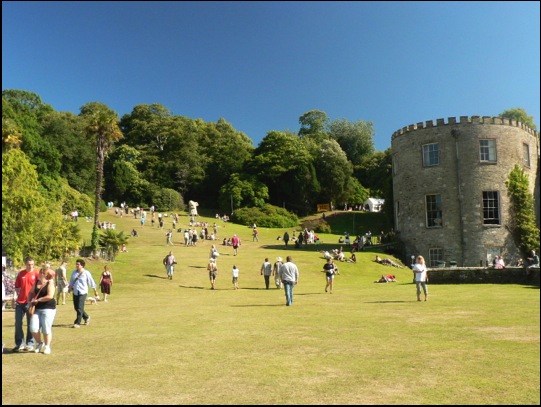
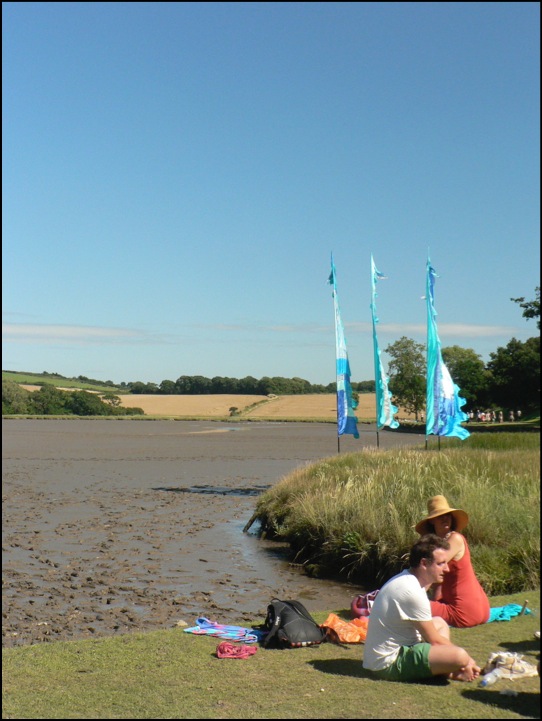
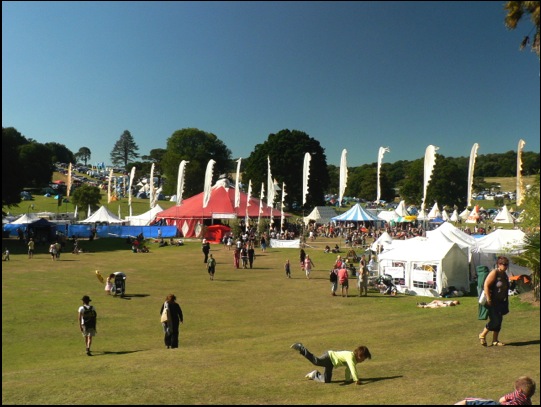
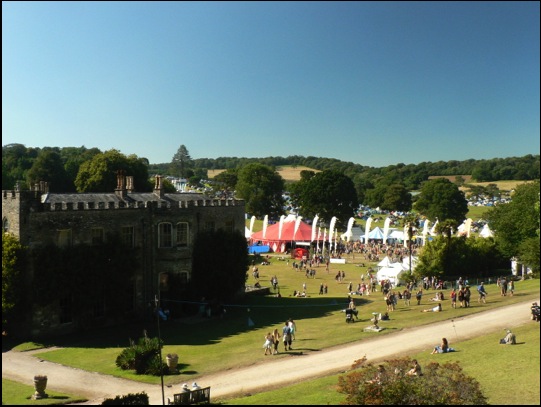
Maybe I’ll see you there, but in the meantime, here are some shots of the Port Eliot landscape and some thoughts about it. The immediate area is a complex one with hard volcanic lavas, ash and ‘tuffs’ making up a west-east ridge of high ground to the estuaries of the Rivers Tiddy and Lynher, while two separate areas of rough slate - which the Cornish refer to as ‘killas’ - run to the north and south of the ridge. The Caught by the River tent was situated in a small quarry which may have provided some killas for the estate walls. You can see the high ground in the first picture and its continuation on the far side of the Tiddy in the second picture - the line of trees mark the course of a cutting that takes the Great Western line towards Plymouth. The lava and ash made their way into the landscape during a time that Southern Britain and Scotland were being welded together around 400 or so million years ago and a Himalayan range of mountains was being formed to the North.




Comments
Dartington
Wednesday, 21 July, 2010. Filed under: Landscapes
More pictures from trains
Monday, 19 July, 2010. Filed under: Landscapes | Views & Scenery
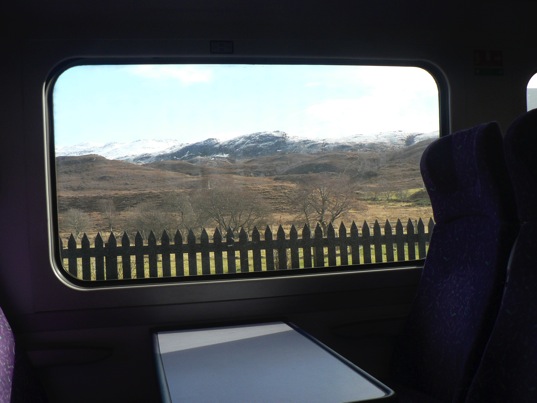
I’ve added a few more photos to the gallery of landscapes taken from trains. It seems like an unconventional way of capturing scraps of scenery as they zoom by and an excellent mental diversion when the novelty of getting out and about wears thin which, as any commuter on Britain’s railways will tell you, can be quite quick.
If you have some train pictures you want to share, feel free to add some in the comments below.
Lay-by of the week:
The Glen Café, St Mary's Loch
Thursday, 15 July, 2010. Filed under: Landscapes
An extra lay-by of the week, found completely by chance while looking for something else. These hills in the Southern Uplands of the Scottish Borders were made by the bulldozing of sediments on an ancient ocean floor when England and Wales - carried on the back of a micro-continent called Avalonia - joined to Scotland (which was still attached to Greenland) over 400 million years ago.
View Larger Map
The lay-by, meanwhile has just about anything you could desire, including a café, phone box, tourist information panel and fantastic views over St Mary’s Loch and it’s southern neighbour, the Loch of the Lowes. Looks like a charming spot. We’d give it a 4.5/5 Thermos rating, but there’s no need to bring one.
View Larger Map
The lay-by, meanwhile has just about anything you could desire, including a café, phone box, tourist information panel and fantastic views over St Mary’s Loch and it’s southern neighbour, the Loch of the Lowes. Looks like a charming spot. We’d give it a 4.5/5 Thermos rating, but there’s no need to bring one.
Lay-by of the week special:
The views from a Devon train
Wednesday, 14 July, 2010. Filed under: Lie of the Land | Landscapes
Back to our normal format next week on the nation’s A-rated, A-road Thermos stops, but I’ve taken the liberty of designating a number of trains in the South west of England as personal lay-bys and attempted to take pictures. They are variable in quality - some trains just seem to be smeared with a veneer of fly corpses, sea splatter and dirty rain. Sometimes polarising the sky for a nice effect also brings out the rectilinear strip light reflections that head off towards our destination, which is an effect I don’t mind too much.
The trains I travelled on were the Great Western 125 mph from Totnes to Exeter and the more modern but 90 mph from Exeter to Salisbury. On my way to Exeter, I was hoping to catch a good view of the fantastic New Red Sandstone cliffs around Dawlish, as featured in The Lie of the Land. I got something of it, through the fly carcasses, and it looks like an old double-exposed holiday slide that has been wedged under a shelf in the garage since the 1970s. It was, at least, nice to make something that came with an instant patina of age on a digital camera.
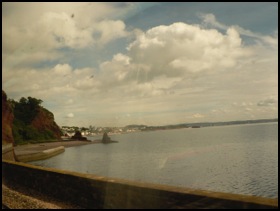
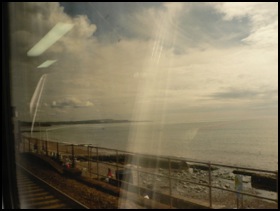
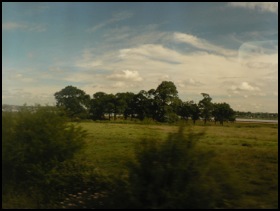
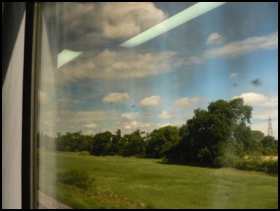
The second two shots are nearer Exeter, of clumps of trees on the Exminster Marshes. By the time that I had got on a cleaner train, I took some more presentable shots of the kind of thing you see from trains, this time mostly between Exeter and Yeovil. This first shot is of some trees in the Axe Valley - I’m hopeless at trees, but they’re in the right environment for Alder and Willow. I like the way they’re all leaning here, as if in agreement with one another.
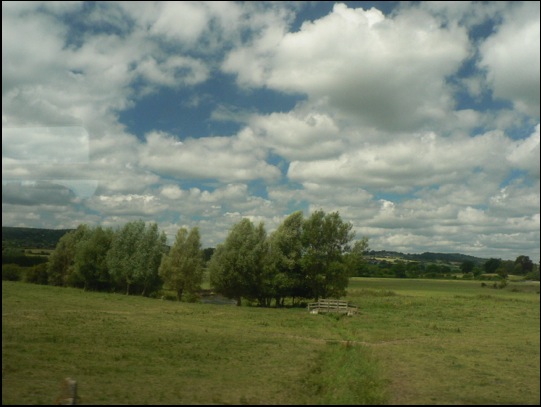
The second shot is quite near Yeovil. The reflections from the train’s internal lighting give the sky some go-faster stripes.
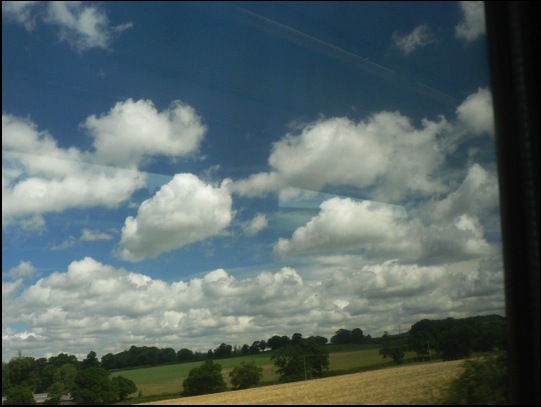
The trains I travelled on were the Great Western 125 mph from Totnes to Exeter and the more modern but 90 mph from Exeter to Salisbury. On my way to Exeter, I was hoping to catch a good view of the fantastic New Red Sandstone cliffs around Dawlish, as featured in The Lie of the Land. I got something of it, through the fly carcasses, and it looks like an old double-exposed holiday slide that has been wedged under a shelf in the garage since the 1970s. It was, at least, nice to make something that came with an instant patina of age on a digital camera.




The second two shots are nearer Exeter, of clumps of trees on the Exminster Marshes. By the time that I had got on a cleaner train, I took some more presentable shots of the kind of thing you see from trains, this time mostly between Exeter and Yeovil. This first shot is of some trees in the Axe Valley - I’m hopeless at trees, but they’re in the right environment for Alder and Willow. I like the way they’re all leaning here, as if in agreement with one another.

The second shot is quite near Yeovil. The reflections from the train’s internal lighting give the sky some go-faster stripes.

Lay-by of the week special
ROAM: The London Lay-by Library
Wednesday, 07 July, 2010. Filed under: Landscapes | Lie of the Land
Bit of a diversion off the A-roads of rural Britain this week into an old mobile library van parked close to an urban A-road or two: the ROAM London project.
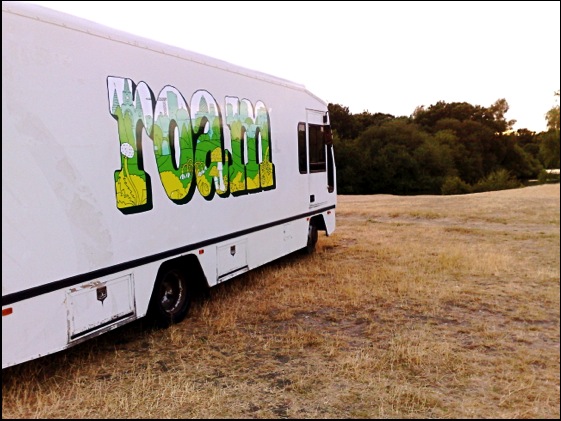
ROAM at Hollow Ponds, Whipps Cross Road
ROAM is touring the five Olympic boroughs of London over the next three weeks as a peripatetic arts space, a mobile reading room and a venue for talks and performance. It has its own reference library and comes complete with a proper parquet floor. It’s the idea of Caught By The River’s Robin Turner and fits well with that website’s general ethos of taking solace in easy, idle pursuits and looking for the rural within our urban lives.
I’ve already had the pleasure of taking the message of the British Landscape Club there and chatting about the Britain beneath its wheels and I’ll be doing it again three more times over the next week and a half, so come and join me.
Friday 9 July 3pm *NOTE NEW TIME*
Beneath Our Feet: Three Billion Years an Hour Through Britain’s Past
ROAM London: Haggerston Park • Parked up behind the tennis courts • E2 8NP
Friday 16 July 7.00pm
Beneath Our Feet: Three Billion Years an Hour Through Britain’s Past
ROAM London: Mile End Park • Grove Road • E3
*NOTE NEW VENUE* (Was at Truman Brewery)
Monday 19 July 7.30pm
Beneath Our Feet: Three Billion Years an Hour Through Britain’s Past
ROAM London: Oxleas Woods • Shooters Hill • SE18 3JA

ROAM at Hollow Ponds, Whipps Cross Road
ROAM is touring the five Olympic boroughs of London over the next three weeks as a peripatetic arts space, a mobile reading room and a venue for talks and performance. It has its own reference library and comes complete with a proper parquet floor. It’s the idea of Caught By The River’s Robin Turner and fits well with that website’s general ethos of taking solace in easy, idle pursuits and looking for the rural within our urban lives.
I’ve already had the pleasure of taking the message of the British Landscape Club there and chatting about the Britain beneath its wheels and I’ll be doing it again three more times over the next week and a half, so come and join me.
Friday 9 July 3pm *NOTE NEW TIME*
Beneath Our Feet: Three Billion Years an Hour Through Britain’s Past
ROAM London: Haggerston Park • Parked up behind the tennis courts • E2 8NP
Friday 16 July 7.00pm
Beneath Our Feet: Three Billion Years an Hour Through Britain’s Past
ROAM London: Mile End Park • Grove Road • E3
*NOTE NEW VENUE* (Was at Truman Brewery)
Monday 19 July 7.30pm
Beneath Our Feet: Three Billion Years an Hour Through Britain’s Past
ROAM London: Oxleas Woods • Shooters Hill • SE18 3JA

